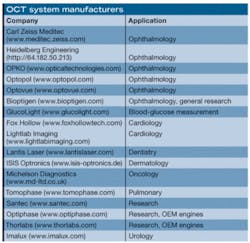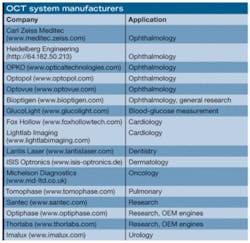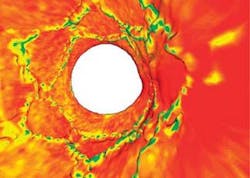OCT market to top $800 million by 2012
Kathy Kincade, Senior Editor
Optical coherence tomography (OCT) is fast becoming the most successful optics technology to date in the field of disease diagnostics. Invented in the early 1990s at the Massachusetts Institute of Technology (Cambridge, MA) and first commercialized for medical applications by Carl Zeiss in 1996, OCT offers fast, high-resolution diagnostic images for a variety of clinical applications, plus the potential to supplant existing imaging modalities in some medical disciplines.
According to Optical Coherence Tomography-Technology, Markets, and Applications: 2008-2012, the first market research report to quantify this rapidly expanding field, the global market for OCT systems is currently around $200 million and growing at an annual rate of 34%. This trend is expected to continue for the next several years, with revenues topping $800 million by 2012. 1
There are several reasons for the increasing end-user interest in OCT. Unlike some imaging techniques, OCT is noninvasive, noncontact, and uses no harmful radiation, while still allowing micron-scale imaging of biological tissue or other samples of interest over short distances. It does this by measuring the time delay and magnitude of reflected light from the sample. OCT is often compared to ultrasound imaging, with the exception that it uses low-coherence light rather than sound waves. Very detailed cross-sectional or 3-D images are rendered through data compilation and visualization software.
While OCT was originally envisioned as a noninvasive tissue-biopsy tool, ophthalmology has become the first commercial application of OCT and should remain the dominant application through 2012. An estimated 37,000 OCT scans are taken daily in the United States for diagnostic purposes in ophthalmology, and last November, at the 2007 American Academy of Ophthalmology meeting in New Orleans, LA, more than a dozen companies had OCT products on hand.
“In 2006, a number of companies introduced spectral-domain systems to the ophthalmic market,” says Greg Smolka, author of the OCT market report published by PennWell. “These systems offer not only much faster image capture but, more important, much higher image accuracy. The new spectral-domain instruments generated a lot of buzz at the 2007 American Academy of Ophthalmology meeting, and many see them becoming the dominant imaging system in ophthalmology.”
Technology shift
Much of this growth is being driven by a shift from time-domain to Fourier-domain OCT. In a basic time-domain OCT system a broadband, low-coherence light source (typically a superluminescent diode) is used as the illumination source. A portion of the light is sent to the sample and another portion is sent to the reference arm in a classic Michelson interferometer. The interference signal between the light reflected from the sample and that reflected from the reference arm is used to build the image.
Translating the reflector on the reference arm of the interferometer is equivalent to optical sectioning of the sample, allowing a map of optical reflectivity versus depth to be generated. The sample is scanned in the transverse direction via various beam-delivery optics, such as galvo mirrors, in the sample arm. The images are typically displayed in grayscale or false color.
While time-domain OCT is utilized in almost all of the commercial systems deployed through 2005, it has some limitations. In particular, because of the nature of the slow mechanical moving speed, the scan time is relatively slow-400 axis scans/s-particularly when compared to next-generation Fourier-domain OCT systems now coming onto the market. While similar in theory and design, the Fourier-domain systems offer twice the resolution and 50 to 100 times the image-acquisition speed. In addition, because the Fourier-domain technique is not protected under the original tightly held patents that have limited competition with time-domain systems, a number of companies are now developing or marketing Fourier-domain OCT products.
This scenario has opened up the commercial market for OCT products. At least 18 companies are now actively developing and/or manufacturing OCT systems, with many more supplying the key optical sources, detectors, and related photonics components that enable the various OCT products and applications (see table).
null
Next market
Outside of ophthalmology, OCT applications and products are emerging in cardiology, dentistry, cancer detection, glucose monitoring, and dermatology. In particular, commercial activity for OCT in intravascular imaging has gained much momentum over the past 12 months, and this sector looks to be the next growth market for OCT technologies. LightLab Imaging (Westford, MA), a subsidiary of the Japanese company Goodman, drew rave reviews from a crowd of more than 1000 interventional cardiologists attending the Transcatheter Cardiovascular Therapeutics conference in Washington, D.C., last October with its live demonstration of real-time spectral-domain OCT images of a recently implanted stent and the tissues covering the stent struts (see figure).
Such technology demonstrations are important given that intravascular ultrasound (IVUS)-currently the dominant imaging modality in this field-is a $400 million market shared by two major players: Boston Scientific and Volcano (San Diego, CA). Recognizing the potential of OCT to offer imagery far superior to IVUS, Volcano in late 2007 announced plans to acquire CardioSpectra (San Antonio, TX), a startup that is commercializing OCT technology originally developed at the University of Texas, for $25 million (plus another $38 million tied to the achievement of certain milestones and regulatory approvals).
CardioSpectra’s core product is based on technology licensed from the University of Texas and Dr. Thomas Milner, cofounder of CardioSpectra. The CardioSpectra system is not yet approved for human use, but the company expects to file for regulatory clearances in 2008. In addition, CardioSpectra holds a number of U.S. patents on its technology, with additional patents pending.
The value Volcano has placed on CardioSpectra’s technology certainly speaks to the market potential its sees for OCT in cardiology. Once approved, OCT will be the only real competitor to IVUS, which is often seen as a necessary evil due to its poor image quality.
“We believe CardioSpectra’s OCT technology and products … will allow us to expand our reach into clinical situations where extremely high-resolution imaging is paramount,” says Scott Huennekens, president and CEO of Volcano.
REFERENCE
1. G. Smolka, Optical Coherence Tomograph: Technology, Markets, and Applications 2008-2012, PennWell Corp., www.BioOpticsWorld.com/resourcecenter/OCTreport.html
Clarification In the article "OCT market to top $800 million by 2012" (see www.laserfocusworld.com/articles/318570; February 2008, p. 49), the following statement requires clarification: "Because the Fourier-domain technique is not protected under the original tightly held patents that have limited competition with time-domain systems, a number of companies are now developing or marketing Fourier-domain OCT products." The key original patent for optical coherent tomography, U.S. Patent 5,321,501, "Method and apparatus for optical imaging with means for controlling the longitudinal range of the sample," was issued on June 14, 1994. Carl Zeiss Meditec (through its subsidiary, Humphrey Instruments) obtained the rights to this patent in ophthalmology in 1994 when the company acquired Advanced Ophthalmic Instruments, a spinoff of Massachusetts Institute of Technology, where the technology originated. Lightlab Imaging, also formed by several of the original OCT inventors, retained rights for all other medical imaging applications and began pursuing nonophthalmic applications and granting application-specific licenses. The '501 patent describes primarily time-domain OCT but also discloses some general concepts of Fourier-domain OCT. The '501 patent was recently re-issued, with 200 new claims on top of the original claim set. These new claims cover several aspects of basic Fourier-domain imaging, as well as many application-specific claims, including ophthalmology, microscopy, and endoscopy. Because the spectroscopic version of Fourier-domain OCT has been described in the open literature (which may pre-date the original patents), the patent situation concerning spectral-domain OCT (a form of Fourier-domain OCT) appears more open to interpretation. As a result, most of the new ophthalmic OCT systems (including the Cirrus from Zeiss) use the spectral-domain technique.
Tell us what you think about this article. Send an e-mail to [email protected].


